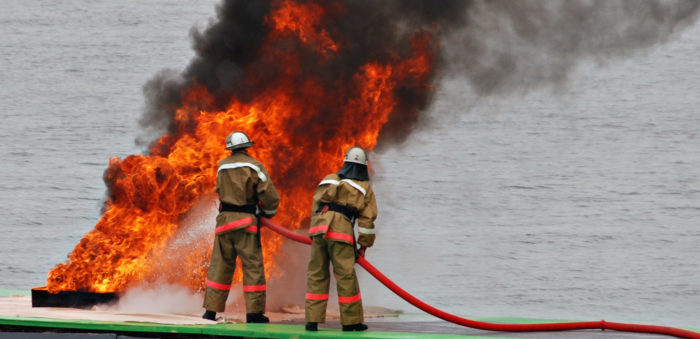A fire is one of the most frightening things that can happen at sea. The Standard P&I Club issued a master’s guide to raise awareness of fire risks on ferries. This type of ship presents particular risks due to the cargo onboard: Cars, lorries and refrigerated containers, all of these have combustible material and their own fire hazards, something which a ship’s crew cannot easily control.
Causes of fire
There are numerous causes of fire but the most relevant to ferries are:
- Electrical defects, such as overloaded electrical equipment, damaged cables and poorly formed connections. Electrical faults in vehicles, especially when engines are hot/running. Reefer containers are major sources of fire.
- Mechanical failure, such as ignition from overheated bearings or a catastrophic engine failure.
- Uncontrolled release of oil or flammable liquid coming into contact with a hot surface, or the release of a low flashpoint fuel, such as petrol vapour, coming into contact with a source of ignition.
- Dry, readily combustible materials (such as wood, paper, textiles) coming into contact with an ignition source, such as a lighted cigarette, sparks or conducted heat from burning or cutting, highintensity lights or defective electrical equipment.
Do
- Ensure that the integrity of structural fire protection is maintained and that it is not compromised during repair and/or modification.
- Make sure penetrations in compartment boundary bulkheads and decks are fire safe.
- Identify where emergency cables run and check that they are adequately protected from fire.
- Have a programme to test fire detectors and alarms so that they are all tested in rotation. Record the results in the log book(s).
- Have a programme to test fixed firefighting system(s) so that the entire system is tested every month. Record the results in the log book(s).
- Hold realistic fire drills followed by a through debrief in accordance with SOLAS.
- Familiarise all crew with the firefighting equipment and the potential means for fire to spread from compartments.
- Test the emergency fire pump and emergency generator during fire drills, ensuring that all crew become familiar with their operation.
- Send all crew on an advanced firefighting course.
- Keep garage spaces clean and free from combustible material, such as oil, paper and rags.
- Keep scuppers clean and free from debris. Water deluge systems can release large volumes of water.
- Stow dangerous goods safely in the properly designated area.
- Fully close fire doors and ramps, and have measures in place to ensure they remain fully closed.
- Have a continuous fire patrol giving special attention to potential fire hazards, such as operating reefer containers/equipment and vehicles with hot engines. • Investigate every lighted ‘open fire door’ indication lamp.
- Investigate every fire alarm.
- Promptly report the discovery of fire.
- Promptly fight fire, in accordance with training.
- Be afraid of smoke – it’s toxic.
- Be afraid of CO2 – it’s an asphyxiant.
Do not
- Cut holes in compartment boundaries or thermal insulation.
- Modify bulkhead or deck pipe and cable penetrations without correctly reinstating fire stopping.
- Paint over release nozzles in a sprinkler, deluge, CO2 or high fog extinguishing system.
- Store oil in drums, wood, paper, oily rags or similar combustible material in garage spaces or in spaces without a fixed fire detection and extinguishing system.
- Wedge a fire door open or disable a door position indicator lamp.
- Allow passengers in vehicles when the ship is navigating, except on those very short voyages where passengers remain in vehicles.
- Smoke, or permit smoking, except in dedicated smoking areas.
- Disable fire detectors or fire alarm zones, without putting alternative precautions in place.
Explore more by reading the full guide:































































